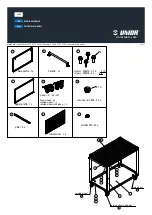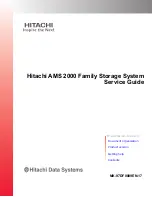
CAUTION:
Removing components from the upper positions in the rack cabinet improves
rack stability during relocation. Follow these general guidelines whenever you
relocate a populated rack cabinet within a room or building:
v
Reduce the weight of the rack cabinet by removing equipment starting at the
top of the rack cabinet. When possible, restore the rack cabinet to the
configuration of the rack cabinet as you received it. If this configuration is not
known, you must do the following:
– Remove all devices in the 32U position and above.
– Ensure that the heaviest devices are installed in the bottom of the rack
cabinet.
– Ensure that there are no empty U-levels between devices installed in the
rack cabinet below the 32U level.
v
If the rack cabinet you are relocating is part of a suite of rack cabinets, detach
the rack cabinet from the suite.
v
Inspect the route that you plan to take to eliminate potential hazards.
v
Verify that the route that you choose can support the weight of the loaded
rack cabinet. Refer to the documentation that comes with your rack cabinet for
the weight of a loaded rack cabinet.
v
Verify that all door openings are at least 760 x 2032 mm (30 x 80 in.).
v
Ensure that all devices, shelves, drawers, doors, and cables are secure.
v
Ensure that the four leveling pads are raised to their highest position.
v
Ensure that there is no stabilizer bracket installed on the rack cabinet during
movement.
v
Do not use a ramp inclined at more than ten degrees.
v
Once the rack cabinet is in the new location, do the following:
– Lower the four leveling pads.
– Install stabilizer brackets on the rack cabinet.
– If you removed any devices from the rack cabinet, repopulate the rack
cabinet from the lowest position to the highest position.
v
If a long distance relocation is required, restore the rack cabinet to the
configuration of the rack cabinet as you received it. Pack the rack cabinet in
the original packaging material, or equivalent. Also lower the leveling pads to
raise the casters off of the pallet and bolt the rack cabinet to the pallet.
(R002)
Power cords
For your safety, IBM provides a power cord with a grounded attachment plug to
use with this IBM product. To avoid electrical shock, always use the power cord
and plug with a properly grounded outlet.
IBM power cords used in the United States and Canada are listed by
Underwriter’s Laboratories (UL) and certified by the Canadian Standards
Association (CSA).
For units intended to be operated at 115 volts: Use a UL-listed and CSA-certified
cord set consisting of a minimum 18 AWG, Type SVT or SJT, three-conductor cord,
a maximum of 15 feet in length and a parallel blade, grounding-type attachment
plug rated 15 amperes, 125 volts.
Safety notices
xv
Содержание H3V
Страница 1: ...IBM System Storage TS2230 Setup Operator and Service Guide Machine Type 3580 Model H3V GC27 3903 00...
Страница 2: ......
Страница 3: ...IBM System Storage TS2230 Setup Operator and Service Guide Machine Type 3580 Model H3V GC27 3903 00...
Страница 6: ...iv TS2230 Tape Drive Setup Operator and Service manual...
Страница 10: ...viii TS2230 Tape Drive Setup Operator and Service manual...
Страница 12: ...x TS2230 Tape Drive Setup Operator and Service manual...
Страница 22: ...xx TS2230 Tape Drive Setup Operator and Service manual...
Страница 84: ...B 2 TS2230 Tape Drive Setup Operator and Service manual...
Страница 97: ...A67E0037 1 6 2 3 4 5 Figure D 8 Attaching the leader pin to the tape Appendix D Repairing a Cartridge D 7...
Страница 98: ...D 8 TS2230 Tape Drive Setup Operator and Service manual...
Страница 119: ...Russia Electromagnetic Interference EMI Class A Statement rusemi Notices F 7...
Страница 120: ...F 8 TS2230 Tape Drive Setup Operator and Service manual...
Страница 139: ......
Страница 140: ...Part Number 46C2369 Printed in USA GC27 3903 00 1P P N 46C2369...
















































